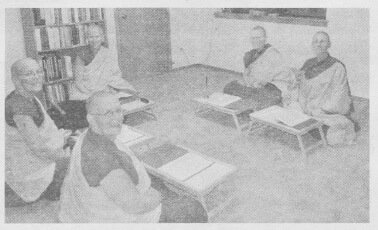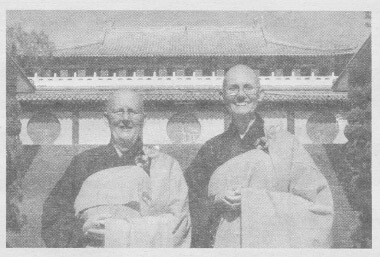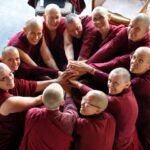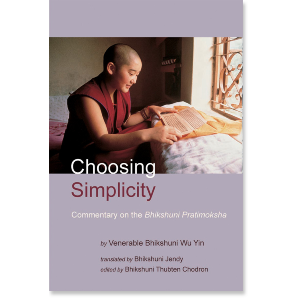| The following article is from the Spring, 2012 issue of the Snow Lion Newsletter and is for historical reference only. You can see this in context of the original newsletter here. |

by VEN. THUBTEN CHONYI
Incense perfumed the air, an offering for the 14,000 Buddha images that line the walls of the Great Hall. I stood with about 200 hundred other women and fifty men, all dressed in graceful dark robes, in impeccably straight rows. Ven. Jigme stood two people behind me, the only Caucasians in a sea of Chinese. Heads up and eyes lowered, we chanted the Chinese homage to Shakyamuni Buddha―namo ben shi shijia mcrn nifo―to the rhythmic tok of a wooden "fish," all minds intent during Fo Guang Shan monastery's full ordination program.
What were two English-speaking American nuns in the Tibetan tradition doing in a Chinese monastery in Taiwan, having no background in the language, culture, or even that particular form of Buddhist practice?
We joined the rigorous four-week program to receive the 348 precepts of a bhikshuni, a fully ordained nun. "I have a very strong motivation to use this life to progress as far as I can on the Buddhist path," Ven. Jigme explained. "For me, the monastic precepts are like a road map and a protector on the journey to awakening."
Practically speaking, so many conditions are required to conduct a full ordination that it is rarely given in the U.S. Traveling to Taiwan was the next most expedient choice.
Four or more bhikshunis or bhikshus are required to perform many of the practices the Buddha established for a fully functional monastic sangha. With our ordination, it now became possible for Sravasti Abbey, our home monastery, to do these.
Bhikshuni Thubten Chodron is the founder of Sravasti Abbey. "To spread the entire Buddhist path," Ven. Chodron explained, "all three baskets of teachings―Vinaya, Sutra, and Abhidharma―must be taught and practiced. In particular, the Buddha stated that the Dharma flourishes where the Vinaya―the monastic discipline―is a living tradition." Choosing Simplicity, a commentary on the bhikshuni precepts by Taiwanese Master Ven. Wu Yin and edited by Ven. Chodron, is published by Snow Lion.
The Buddha taught the necessity of nurturing the four-fold sangha―male and female lay practitioners and fully ordained monks and nuns. "It's not just the existence of individual practitioners that is important," Ven. Chodron said. "A community of four or more fully ordained monastics is crucial for the flourishing of the Buddha's doctrine."
Buddhist monastic communities are rare enough in the U.S., especially those geared to Western students. Sravasti Abbey is even more unique in that full ordination for women is not available in the Tibetan tradition. As far as we can ascertain, the Abbey is the only complete community of bhikshunis practicing in the Tibetan tradition in the U.S., and there are only a few in the world.
Ten fully ordained senior nuns and ten equally qualified monks―or five each in outlying areas like the U.S.―are required for the nuns' ordination to be given. Possibly because of dangerous travel conditions, the bikshuni lineage was not established in Tibet. However, the bhikshuni sangha arrived and thrived in China. In Taiwan, where mainland monastics fled to escape the communist takeover, bhikshunis make up roughly three fourths of the monastic population.

Above photo: Ven. Jigme and Ven. Chonyi at Fo Guang Shan monastery. Left: First sojong together as fully ordained nuns at Sravasti Abbey.
Ven. Chodron received novice ordination in India in 1977 and trained with Tibetan Buddhist masters, including His Holiness the Dalai Lama. She soon discovered that some opportunities, such as full ordination, were not available to her as a woman.
She recalls, "We heard about nuns in Taiwan―they were fully ordained, well educated, and carried responsibilities equal to the monks. A few of us Western nuns were interested in receiving full ordination in order to train our minds in this way."
In 1986 she revealed her bhikshuni aspiration to His Holiness the Dalai Lama. I'll make prayers for you, he affirmed. And so, with the blessings of her teacher, she traveled to Taiwan to take full ordination.
I recently met with His Holiness, Ven. Chodron said. He was very pleased to hear that we have five bhikshunis ordained in the Dharmagupta Vinaya tradition.
Historians say it takes 300 years for the Buddhadharma to take root in a new region. The first known American refuge ceremony took place in 1893, so we're barely a third of the way there.
THUBTEN CHONYI began her Dharma study with Ven. Thubten Chodron at Dharma Friendship Foundation in Seattle in the mid- 1990s. She received bhikshuni ordination in November 2011.


